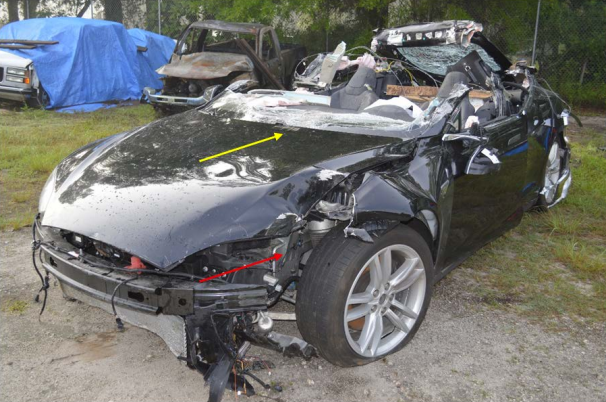Why self-driving cars are in the slow lane
You’re going to hear a lot about self-driving cars before they actually arrive.
I recently drove a demonstration vehicle Nissan outfitted to highlight its latest autonomous system, which the automaker calls ProPilot Assist. As you can see from the video above, it doesn’t exactly chauffeur me around while I read a magazine or answer email. “We’re being conservative,” says Nissan engineer Andy Christensen, who rode with me on the demo around New York City and explained how the technology works. “We know the importance of keeping the driver engaged.”
The big automakers are all vying for pole position on autonomous technology, but there’s a catch—rolling it out too fast risks turning off drivers and even harming them. That lesson comes from a crash last year in which a Tesla driver died when he struck a tractor-trailer at 74 miles per hour while his vehicle’s “Autopilot” system was engaged. Federal investigators cited overreliance on the technology as a factor in the crash.
The Tesla system allowed the driver to cruise for extended periods without his hands on the wheel, while self-driving software handled the steering. Nissan’s ProPilot Assist doesn’t go that far. Like systems from other automakers, it has two basic features. First, it’s able to keep the car within its lane on a highway, as long as there are lane markers that sensors on the car are able to read. It also uses radar cruise control to adjust the speed of the car based on the distance to the car ahead, slowing down if the distance gets too tight, then speeding up again as the space increases.
To work, however, the driver must have at least a couple fingers on the wheel, to assure you don’t zone out or doze off. If sensors detect that you’ve let go, the system will beep to get your attention, then disengage if you don’t respond. You can see that happen a couple times in the video.
Level 2 autonomy
The Nissan system is Level 2 autonomy, which is the third of six levels ranging from 0 to 5. That means computers can do some of the steering, accelerating and braking, as long as the driver stays in control of the vehicle and monitors the whole driving environment. ProPilot Assist will be available on the 2018 Leaf, hitting showrooms soon, and on other Nissan models after that. Other automakers offer similar technology, which typically hits luxury makes first and filters down to the mainstream fleet.

The best thing about Level 2 autonomy is radar cruise control, which relieves the driver of continually resetting it when the speed of travel slows in traffic. Instead, you set a maximum speed and the system slows the car as needed, then speeds up again when the coast is clear. ProPilot Assist will actually slow the car all the way to 0—ideal for stop-and-go-driving—then accelerate as traffic eases, as you can see in the video. The only catch is that if you’re stopped for more than a few seconds, you have to push a button to reengage cruise.
The self-steering feature on ProPilot Assist is less compelling, perhaps because the need to keep your hand on the wheel doesn’t really provide much of a break. Tesla’s system at the time of the fatal Florida crash last year was hands-free, except when sensors detected circumstances that would require the driver to retake the wheel. An investigation by the National Transportation Safety Board (NTSB) found that the driver of that car had the autonomous system engaged for 37 minutes before the crash and only had his hands on the wheel for about 25 seconds during that time. While Autopilot was engaged, the vehicle issued seven alerts instructing the driver to take the wheel—but Autopilot never disengaged, as it is designed to do if it detects a safety hazard and the driver doesn’t respond.
The crash occurred on a four-lane state highway as a tractor-trailer was turning left in front of the Tesla. Sensors on the Tesla didn’t detect the truck, and there’s no indication the driver hit the brakes or did anything to avoid hitting it. Cruise control was set at 74 miles per hour, the speed at which the Tesla struck the truck before sliding underneath it and veering off the road. The NTSB identified several causes of the crash: the truck’s failure to yield to the Tesla, the driver’s “overreliance on vehicle automation,” and technology that allowed the driver “prolonged disengagement from the driving task.”
Tesla modified its Autopilot software after the crash, reducing the amount of time the driver can cruise hands-free before an alert sounds, and making other changes. But it’s still a hands-free system.
The other hands-free system on the market is General Motors’s “Supercruise” feature, available on the 2018 Cadillac CT6 sedan. That system relies on a “driver-tracking camera” in the cabin, along with “head-tracking software,” to make sure the driver is paying attention. If not, a series of alerts ensue, and if the driver doesn’t respond, the system will disengage. Like Nissan’s system, it can adjust the vehicle’s speed as needed and keep the car in its lane. But the driver must still execute simple maneuvers like changing lanes or exiting the highway. If the system is on and there’s no driver input when required, these and other autonomous systems are designed to slow the vehicle gradually and bring it to a stop, as safely as possible. A proper self-driving car must be self-stopping, too.
Confidential tip line: rickjnewman@yahoo.com.
Read more:
Rick Newman is the author of four books, including Rebounders: How Winners Pivot from Setback to Success. Follow him on Twitter: @rickjnewman.

